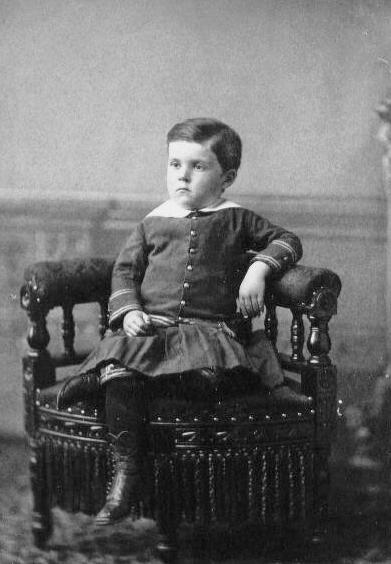
"Small Boy's Clothes" : Harper's Bazar (1877)

Figure 1.--As far as we know, the "Harper's" 1877 article was not illustrated. Here is an example of an American kilt suit from the 1870s. This Chicago boy wears akilt suit with, as almost always was the case, long stockings. The black and white photograpy offers few clues as to color, but Harper's makes it clear that the color was quite varied in the 1870s. By the 1890s, however, long sockings were mostly black. Notice that this boy wears brightly trimmed knee pants with his kilt suit.
|
|
Articles on style and fashion in contemprary magazines are very important in understanding contemporary fashion trends and terminology. They help understand the phphographs archived on HBC. We can make outmany clothing details in the photographs, but the stlistic conventions are often more elusive. We are constantly looking for these articles addressing boys' fashions. We note a brief article on "Small Boy's Clothes" from Harper's Bazar Magazine. We are not yet sure precisely when it appeared in Harper's, but presume it was earlier in 1877. The copy we found was in the Waterloo Courier (July 18, 1877, page 2). This was the Waterloo, Iowa newspaper. It describes the fashionable styles for young boys to wear before they are breached.
Harper's Text
The favorite dress for small boys not yet in trousers is a single
garment with the front in princesse shape, that is, a long sloped
sacque reaching just below the knee, either single or double-breasted,
and buttoned from top to bottom. The back is sloped by seams to partly
fit it over the hips, where a belt is put on to conceal the seam that
joins the kilt-pleated skirt below: this belt and the kilt pleats are
confined to the back. For every-day wear it is made of brown linen
drilling, bound with brown braid and ornamented with substantial white
or brown pearl buttons. These cost $3.00 at the furnishing houses.
Made of repped pique, and trimmed with buttons down the side, they cost
$4.50; others, with an extra jacket in front, are the same price.
Similar garments made of light summer cloth are $6.00 if plain, or
$8.00 with jacket fronts. These are pretty in navy-blue cloth for the
seaside. They are trimmed with one or two rows of white Hercules
braid; there are also gray cloth coats with black braids, but these are
not as pretty as the twilled wools in shepherd check, black, brown, or
blue with white, for $6.50.
For those who prefer kilt skirts, there are flat skirts of repped
pique, made of three breadths laid in a few broad box pleats or in many
side pleats, sewed to a pointed girdle or very broad belt in order to
give the desirable slenderness. The novel jacket to wear with these is
a Breton sacque, in straight French shape, double-breasted, with two
rows of braid and pearl buttons down the front, while the back has
three rows across in Breton fashion. These cost $8.50 up. The
plainest pique braids, about half an inch wide, are used for trimming
small boys' suits. These are also single-breasted jackets and kilt
skirts for $7.00. Petticoats needed for warmth under these skirts are
scant and closely gored. Warm under-drawers and vests of gauze or of
silk are used instead of the many cotton garments formerly worn. Very
small boys wear short socks, showing part of the bare limb below their
skirts, but larger boys wear long stockings over their knees of solid
blue, brown or red, or else barred with white. Sailor hats or mixed
white and colored straws are most worn by these little fellows.
Comments
There is quite a bit of useful information here about dresses, kilt suits and long stockings.
Dresses
Kilt suits
Long stockings
The color information is useful and confirmation about the striped stockings ("barred black and white"); also the color red chimes with some of the illustrations we already have. This was even mentioned in Mrs. Burnett's classic, Little Lord Funtleroy.
Underwear
Headwear
HBC

Navigate the Boys' Historical Clothing Web Site:
[Return to the Main U.S. 1870s chronology page]
[Return to the Main U.S. late 19th century chronology page]
[Return to the Main 1870s chronology page]
[Introduction]
[Activities]
[Biographies]
[Chronology]
[Clothing styles]
[Countries]
[Bibliographies]
[Contributions]
[FAQs]
[Glossaries]
[Images]
[Links]
[Registration]
[Tools]
[Boys' Clothing Home]
Created: 10:43 PM 1/15/2009
Last updated: 10:43 PM 1/15/2009



